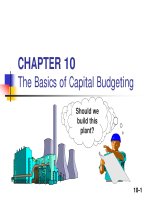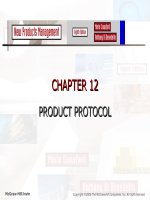New Products Management - CHAPTER 10 THE FULL SCREEN pps
Bạn đang xem bản rút gọn của tài liệu. Xem và tải ngay bản đầy đủ của tài liệu tại đây (591.21 KB, 15 trang )
CHAPTER 10
CHAPTER 10
THE FULL SCREEN
THE FULL SCREEN
McGraw-Hill/Irwin
Copyright ©2006 The McGraw-Hill Companies, Inc. All right reserved.
The Full Screen
The Full Screen
A step often seen as a necessary evil, yet very powerful and
with long-lasting effects.
Forces pre-technical evaluation, and summarizes what must
be done.
Methods range from simple checklists to complex
mathematical models.
Purposes of the Full Screen
Purposes of the Full Screen
To decide whether technical resources should be
devoted to the project.
Feasibility of technical accomplishment can we do it?
Feasibility of commercial accomplishment do we want to do
it?
To help manage the process.
Recycle and rework concepts
Rank order good concepts
Track appraisals of failed concepts
To encourage cross-functional communication.
Screening Alternatives
Screening Alternatives
Judgment/Managerial Opinion
Concept Test followed by Sales Forecast
(if only issue is whether consumers will like it)
Scoring Models
A Simple Scoring Model
A Simple Scoring Model
Values
Factors: 4 Points 3 Points 2 Points 1 Point
Degree of Fun
Number of People
Affordability
Capability
Much
Over 5
Easily
Very
Some
4 to 5
Probably
Good
Little
2 to 3
Maybe
Some
None
Under 2
No
Little
Student's Scores: Skiing Boating Hiking
Fun 4 3 4
People 4 4 2
Affordability 2 4 4
Capability 1 4 3
Totals 11 15 13
Answer: Go boating.
Figure 10.2
Source of Scoring Factor Models
Source of Scoring Factor Models
Figure 10.3
A Scoring Model for Full Screen
A Scoring Model for Full Screen
Note: this model only shows a few sample screening factors.
Factor Score (1-5) Weight Weighted Score
Technical Accomplishment:
Technical task difficulty
Research skills required
Rate of technological change
Design superiority assurance
Manufacturing equipment
Commercial Accomplishment:
Market volatility
Probable market share
Sales force requirements
Competition to be faced
Degree of unmet need
Figure 10.4
The Scorers
The Scorers
Scoring Team:
Major Functions (marketing, technical, operations, finance)
New Products Managers
Staff Specialists (IT, distribution, procurement, PR, HR)
Problems with Scorers:
May be always optimistic/pessimistic
May be "moody" (alternately optimistic and pessimistic)
May always score neutral
May be less reliable or accurate
May be easily swayed by the group
May be erratic
IRI (Industrial Research institute) Scoring
IRI (Industrial Research institute) Scoring
Model
Model
Technical success factors:
Proprietary Position
Competencies/Skills
Technical Complexity
Access to and Effective
Use of External
Technology
Manufacturing Capability
Commercial success factors:
Customer/Market Need
Market/Brand
Recognition
Channels to Market
Customer Strength
Raw
Materials/Components
Supply
Safety, Health and
Environmental Risks
Source: John Davis, Alan Fusfield, Eric Scriven, and Gary Tritle, “Determining a Project’s Probability of Success,” Research-Technology Management,
May-June 2001, pp. 51-57.
Figure 10.5
Alternatives to the Full Screen
Alternatives to the Full Screen
Profile Sheet
Empirical Model
Expert Systems
Analytic Hierarchy Process
A Profile Sheet
A Profile Sheet
Figure 10.6
Criteria Based on the NewProd Studies
Criteria Based on the NewProd Studies
Must-Meet Criteria (rated yes/no):
Strategic alignment
Existence of market need
Likelihood of technical feasibility
Product advantage
Environmental health and safety policies
Return versus risk
Show stoppers (“killer” variables)
Figure 10.7
Criteria Based on the NewProd Studies
Criteria Based on the NewProd Studies
(continued)
(continued)
Should-Meet Criteria (rated on scales):
Strategic (alignment and importance)
Product advantage (unique benefits, meets
customer needs, provides value for money)
Market attractiveness (size, growth rate)
Synergies (marketing, distribution, technical,
manufacturing expertise)
Technical feasibility (complexity, uncertainty)
Risk vs. return (NPV, IRR, ROI, payback)
Figure 10.7
(cont’d.)
Products 1, 2, 3, and 4
Goal: Select Best NPD Project
Market Fit Tech. Fit Dollar Risk Uncertainty
Product Line
Channel
Logistics
Tim ing
P rice
S al es Force
Desi gn
Mat erials
S uppl y
Mfg. Tec h.
Mfg. Tim ing
Diff erential
A dvantage
P ayof fs
Losses
Unmitigated
Mi tigat ed
P roduct Line
Products 1, 2, 3, and 4
Goal: Select Best NPD Project
Market Fit Tech. Fit Dollar Risk Uncertainty
Product Li ne
Channel
Logistics
Tim ing
P rice
S al es Force
Desi gn
Mat erials
S uppl y
Mfg. Tec h.
Mfg. Tim ing
Diff erential
A dvantage
P ayof fs
Losses
Unmitigated
Mi tigat ed
P roduct Line
Analytic Hierarchy Process (AHP)
Analytic Hierarchy Process (AHP)
Figure 10.9
Ranking of Alternatives:
Project Overall Weight
P1 0.381
xxxxxxxxxxxxxxxxxxxxxxxxxxxxxxxxxxxxxx
P2 0.275
xxxxxxxxxxxxxxxxxxxxxxxxxxxx
P3 0.175
xxxxxxxxxxxxxxxxxx
P4 0.170
xxxxxxxxxxxxxxxxx
Abbreviated Output from AHP
Abbreviated Output from AHP
Figure 10.9









